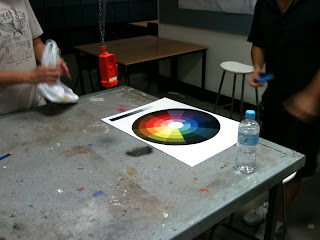I originally wanted to make my lamp as simple as it could get as I always thought simple looks the best. In order to get the right lampshade, I have tried various different shapes and techniques. However, as there were quite a few limitations that the project had; including reducing wastage, flat packing, I tried scoring a lot like many other students in order to achieve a variety in shapes. I think having strips lets the lamp to be more organic and active. But strips could make a model to look like a paper structure rather than a lamp; so I wanted to keep the essence of lamp but having strips.
As I have continued to experiment, I wanted to have more variety in my lampshade. So, I thought of using two different techniques in one model. For example, I could have a structure with strips and another structure with totally different technique to make the model less boring and interesting. So, as final lamp model, I have come up with a lamp with two structures; one which is colourful and has a unique shape with strips and another one with white colour that has rather simple shape and structure.
Originally, since the lamp is supposed to be environmentally friendly throughout the entire process from ‘manufacture’ to ‘flat packed’ and lastly ‘deliver’ to users, I wanted to set the concept of the lamp to be natural as well like a lotus. So, for the final lamp, at first attempt, the model was consisted of 4 wide strips but being 4 made the model look quite boxy and boring. Consequently, I have made it to be 6 wide strips which are easy to assemble with total 11 canoe clips and 11 short steel wires. The flat packed model is consisted of 4 wide strips (1000mm x 200mm) and 2 narrower strips (1000mm x 170mm) so that it makes the shape to have more variety within the actual strip structure.
Ultimately, the final lamp has both active, organic structure inside and relaxed and calming structure outside. I liked how the scored strips flow with forming unique volumes when they are hooked with wires. So I named the lampshade after Japanese Zen style as the flow of the lines reminded me of the style a lot.
The inner structure of the lamp is basically all strips so they tend to spread out the light even which may seem quite boring. However, the 3 outer white wing-like units on top of the inner structure block the light to go all over the place but lets it illuminate its white background (including letters and colours on the back). It eventually forms interesting illumination like a star as shown in the product poster.





































